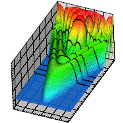Department of Physics and Astronomy: Publications and Other Research

Anthony F. Starace Publications
Document Type
Article
Date of this Version
1-14-2001
Abstract
High-order harmonic generation (HHG) has become a main topic of intense laser-atom physics. Both to understand the HHG process better and to enhance its use in applications, many studies have focused on the control of HHG. Among the most recent are those concerned with the polarization characteristics of the harmonics. Other studies have focused on the use of a strong static electric field to control the intensities and plateau structure of HHG. In this paper we present results of a general formulation of the problem of HHG in the case when the generating medium is anisotropic. Our specific results are for the case of anisotropy introduced by a strong, static electric field. However, we discuss also other ways of introducing anisotropy for which our analysis applies and for which similar results may be expected. We show that a static electric field has striking effects on tlie polarization of high-order harmonics and on the dependence of harmonic yield on the laser field ellipticity. We demonstrate that: (i) in the presence of a static electric field the harmonics are in general elliptically polarized, even for a linearly polarized driving laser (which contrasts with results obtained in the absence of a static field), and (ii) the static electric field leads to a significant elliptic dichroism effect, i.e., the intensity of a harmonic differs substantially for right and left helicities of an elliptically polarized laser beam. We also discuss elliptic dichroism in the case when the generating medium is isotropic but a polarization sensitive detector is used for harmonic intensity measurements. All of these results demonstrate the possibility of significant control of polarization effects in HHG.


Comments
Published in Super-Intense Laser-Atom Physics, edited by Bernard Piraux and Kazimierz Rzążewski. NATO Science Series: Series II: Mathematics, Physics and Chemistry – Vol. 12. Dordrecht / Boston / London: Kluwer Academic Publishers, 2001. Proceedings to the NATO Advanced Research Workshop on Super-Intense Laser-Atom Physics, Han-sur-Lesse, Belgium, September 24–30, 2000. Copyright © 2001 Kluwer Academic Publishers. Used by permission.